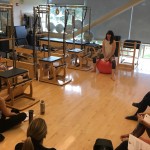September 26, 2018
The Art of Asking Questions
Why some questions aren’t worth asking and the right questions change EVERYTHING
By Chantill Lopez
“That feels great, right?”
(Teacher as all knowing — You feel what I think you feel, right?)
“Can you feel/find that?”
(Teacher as mildly and unintentionally condescending — Because if you don’t feel that you’re probably not doing it right.)
“Can’t you feel/see how that’s different than before?”
(Teacher as expert change-creator — Can’t you feel/see what I see?)
“Doesn’t that feel better?”
(Teacher leading the witness — Just plain NOT FAIR!)
Asking good questions … who cares?
You should.
Most of us don’t even know that asking good questions — and by good I don’t mean right, I mean well-crafted, thoughtful, intentional, and well-timed questions that are actually going to help your student discover something for themselves — is even a skill we can or should develop. Mostly what we’re concerned with is getting right what we’re offering, sharing, and telling our students to do.
What’s the right way to breathe, the correct form, the appropriate and safe biomechanical rhythm, the best joint ROM to encourage, the correct … correction, the most insightful adjustment, the most effective release? On and on and on — telling, outputting, giving, directing, instructing. Us to them. Empty vessel. Fill. Up.
All appropriate. Training the body in front of us = our job. Or is it?
So why ask questions?
We could undoubtedly train a student pretty well without asking any meaningful questions at all: establish good alignment and decent recruitment; produce adequate joint mobility and stability; get them to move through fairly complex choreography.
Is training your student all you want to do?
If you’re only trying to train your students, you are essentially … replaceable. There are thousands of teachers (literally and likely more) who could train your student as well or better than you. I know that may sound harsh, but I mean it about myself too and about all of the teachers I know. At some point, good training is just about having good enough clarity, experience, and some solid bits of knowledge. Truthfully, none of which is all that hard to come by.
So asking questions is NOT about training better.
Getting good at asking questions is also NOT merely — or rather rarely — about communicating MORE. It’s about communicating better and with more refinement. Knowing when to be quiet. To wait. Watch. Wait some more. Listen. Because let’s face it, most of us are saying way too much of nothing much at all. (Again, I can’t exclude myself from this category completely. It’s a lot of work to shut up.)
Asking questions is about inviting your student to be present with their experience and getting them to join their party! It’s a way of creating an environment of curiosity, not necessarily about the work, but ABSOLUTELY about their body.
What else does asking (good) questions do?
- Makes your students (and you) smarter because it’s harder than just dictating moves
- Gives your students permission to explore and not have to “get it right”
- Requires your students to be discerning
- Creates space for your students to discover their own answers
- Creates opportunity for your students to take ownership (fosters self-efficacy and autonomy)
- Develops intrinsic motivation
- Forces you to LISTEN BETTER and not always have to have all the answers (shifts you from “teacher as expert” to “teacher as co-creator.” Woo hoo!)
It’s also one of skills that most obviously sets teachers (facilitators/coaches) apart from instructors (trainers).
The word “teach” comes from the Latin word ducere, meaning “to lead.” According to Merriam-Webster’s dictionary: “To educate, or teach, is to lead to knowledge. To induce is to lead into a particular state.”
TEACHING is a means of leading a student out of (or the way I think of it, back to) themselves. It’s about facilitating a shift in behavior — not for the sake of psychological change, which is clearly not within our scope of practice — but for the sake of conscious physiological change that is replicable and long-lasting, driven largely by the student’s own volition. The former happens anyway.
Open questions and motivational science at work.
First things first. Avoid questions that can simply be answered “yes” or “no.” Instead, try to always ask open questions — ones that have answers that are anything but yes or no. It’s so simple, but it means that your student has to dig a little for their answer. It also means that YOU have to dig a little in order to help them find their way.
Open questions are a pivotal part of Student-centered Teaching and Motivational Interviewing, both rooted in humanistic psychology. Crafting these types of questions takes care and thought and, most importantly, it shows an interest in helping your student discover something about their experience.
William Miller and Stephen Rollnick, creators of Motivational Interviewing, write: “It is the [student] who should be voicing the arguments for change.” This is what the open question does. It gets your student to discover evidence that change is possible from inside their own experience rather than from you telling them.
Examples of open questions:
- What can’t you do on a daily basis because your back hurts?
- You said you want to build core strength, what does that mean to you?
- What would you like to be able to do again that you stopped being able to do since your hip replacement?
- What happens in your left leg when you work more through your big toe?
- Where are you driving the movement in your arms from?
- If you work less in your neck as you roll up, where does the effort go?
- For the next 3-4 reps, I want you notice how your left shoulder is working. (After reps) What could you do differently to find balance between the sides?
How do you ask good questions?
Let’s establish some guidelines for venturing into good question asking.
- Always remember LESS IS MORE.
- Never ask a question and then say, “right?” It’s condescending and tells the student that there’s only one answer. Your answer.
- Choose your words carefully and thoughtfully. Don’t use words that you think sound smart or you don’t fully understand or more importantly that your students don’t understand. Be straightforward and not too esoteric.Some questions that won’t work (for most of us):
- “Imagine what it would be like if you were moving through something viscous. How would you use your hamstring?”
- “What does your body want to do when you allow your natural bio-intelligence to inform your foot?”
- “What part of your back is creating buoyancy in that arm-pulling action?”
None of these are “bad” per se, but I’d bet that they are all a bit of a stretch.
- Be specific. If you want to know what a student’s feeling, don’t ask “What are you feeling?” Guide them. If you want to know what it feels like for them to incorporate a correction you gave them in pulling straps, ask specifically:“When you pull your arms back to your hips that way, what’s the experience in your neck?”OR“Where are you initiating from when you extend your legs?”
- Set them up for success. Don’t just ask “What do you notice?” or “How does it feel when…?” Set them up and direct their attention first. Then ask an open question.
Asking good quality, well-thought-out questions is not really that hard. You just have to WANT to do it and be driven to discover something deeper about your student’s potential. And … it certainly takes practice. Start small. Be yourself. What do you really want to help your students achieve? (See that? … Now, that’s a good open question!)
 Chantill Lopez – “Be real. Don’t fake it. Be able to say I don’t know. Laugh at myself. Extend compassion to myself and my students. Enter in fully, every time, ready or not.”
Chantill Lopez – “Be real. Don’t fake it. Be able to say I don’t know. Laugh at myself. Extend compassion to myself and my students. Enter in fully, every time, ready or not.”
After more than 20 years of teaching, 17 of which have been spent teaching Pilates, yoga, dance, meditation and other movement modalities to a complex variety of folks, Chantill’s passion is teaching teachers.
She holds Pilates certifications from the PhysicalMind Institute and Body Kinetics with Master Teacher Carol Appel, is a certified Vinyasa yoga teacher, and has extensively studied the work of Philip Beach, Yamuna Body Rolling, Feldenkrais, the Franklin Method, Authentic Movement, and the Halprin Life/Art Process, as well as Vipasana meditation, Buddhist psychology and The Work by Byran Katie. Chantill’s work currently explores brain-based learning and teaching, motivational strategies, and the integration of the whole-person based on such ideas as somatic and humanistic psychology and the polyvagal theory by Stephen Porges.
She is a Pilates Method Alliance Certified Pilates Teacher (CPT), a Balanced Body Pilates faculty member and the founder of the international education company, Skillful Teaching. Chantill is also the creator of the Thinking Pilates Podcast and author of the book “Moving Beyond Technique,” and the co-creator of the Science + Psychology of Teaching Master’s Program.
You can find Chantill teaching throughout the U.S. and offering online coursework and support to teachers around the world. She actively teaches out of several studios in the Northern California & Bay Area including Sonoma and Napa counties, Sacramento and San Francisco.

